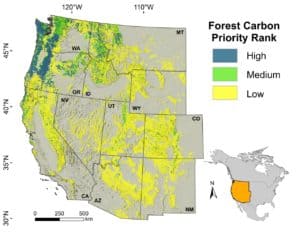OSU professor Beverly Law and her researchers have published another paper on a topic we’ve discussed before, such as here — that it would be better, carbon-wise, to preserve forests rather than harvest timber. This new paper builds on that theme
Carbon sequestration and biodiversity co-benefits of preserving forests in the western USA
Authors: Polly C. Buotte1, Beverly E. Law, William J. Ripple, Logan T. Berner
Abstract and conclusions below. The paper is behind a pay wall.
I noted in the abstract that the authors based their modeling on “two high-carbon emission scenario (RCP 8.5) climate models.” RCP 8.5 was the subject of a recent article in Forbes by Roger Pilke Jr., “It’s Time To Get Real About The Extreme Scenario Used To Generate Climate Porn,” in which he says RCP 8.5 is a “worst-case scenario” and that “it may not even be a plausible worst-case scenario, because it requires improbable changes to our global energy policies, such as a wholesale return to coal throughout the 21st century and the abandonment of natural gas and renewables.”
So I hope any discussion here the Buotte/Law article will focus on climate modeling and scenarios, rather than the proposal to preserve much of the west-side forests and reduce harvesting (though that certainly is a topic of interest).
Abstract:
Forest carbon sequestration via forest preservation can be a viable climate change mitigation strategy. Here we identify forests in the western conterminous United States with high potential carbon sequestration and low vulnerability to future drought and fire, as simulated using the Community Land Model and two high-carbon emission scenario (RCP 8.5) climate models. High-productivity, low-vulnerability forests have the potential to sequester up to 5,450 TgCO2 equivalent (1,485 Tg C) by 2099, which is up to 20% of the global mitigation potential previously identified for all temperate and boreal forests, or up to ~6 years of current regional fossil fuel emissions. Additionally, these forests currently have high above- and belowground carbon density, high tree species richness, and a high proportion of critical habitat for endangered vertebrate species, indicating a strong potential to support biodiversity into the future and promote ecosystem resilience to climate change. We stress that some forest lands have low carbon sequestration potential but high biodiversity, underscoring the need to consider multiple criteria when designing a land preservation portfolio. Our work demonstrates how process models and ecological criteria can be used to prioritize landscape preservation for mitigating greenhouse gas emissions and preserving biodiversity in a rapidly changing climate.
Conclusions:
If we are to avert our current trajectory towards massive global change, we need to make land stewardship a higher societal priority (Chan et al. 2016). Preserving temperate forests in the western US that have medium to high potential carbon sequestration and low future climate vulnerability could account for approximately eight years of regional fossil fuel emissions, or 27-32% of the global mitigation potential previously identified for temperate and boreal forests, while also promoting ecosystem resilience and the maintenance of biodiversity. Biodiversity metrics also need to be included when selecting preserves to ensure species-rich habitats that result from frequent disturbance regimes are not overlooked. The future impacts of climate change, and related pressures as human population exponentially expands, make it essential to evaluate conservation and management options on multi-decadal timescales, with the shared goals of mitigating committed CO2 emissions, reducing future emissions, and preserving plant and animal diversity to limit ecosystem transformation and permanent losses of species
